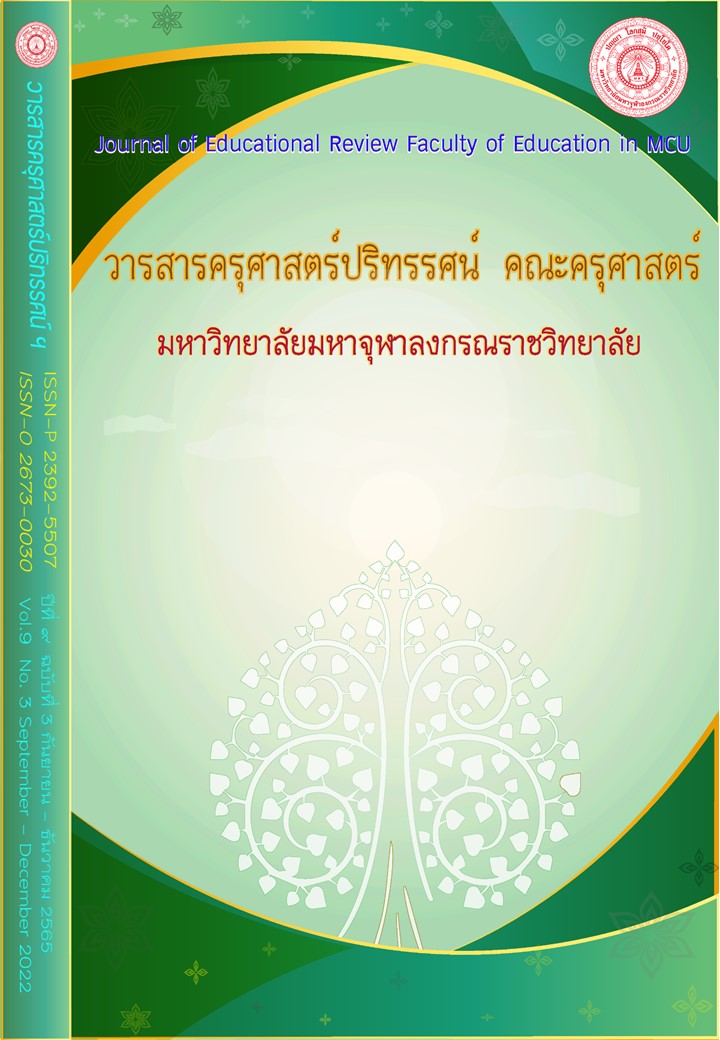THE EFFECTS OF STEM EDUCATION IN SCIENCE FOR ELECTRICAL ELECTRONICS AND COMMUNICATION WORKS ON PROBLEM-SOLVING ABILITIES AND ATTITUDETOWARDS SCIENCE OF HIGH VOCATIONAL CERTIFICATE STUDENTS AT THALUANGCEMENTHAIANUSORN TECHNICAL COLLEGE IN SARABURI PROVINCE
Main Article Content
Abstract
The purposes of this research article were 1) to compare the students’ problem solving abilities before and after receiving instruction using STEM education in Science for Electrical Electronics and Communication Works, and 2) to compare the students’ attitude towards science subject before and after receiving instruction using STEM Education in Science for Electrical Electronics and Communication Works. The samples used in the experiment were 37 1st year advanced vocational certificate students enrolled in Science for Electrical Electronics and Communication Works in the first semester of the academic year 2020 at Thaluang Cementhaianusorn Technical College in Saraburi Province. The samples were obtained by purposive sampling. The research instruments were 1) 5 STEM education lesson plans in Science for Electrical Electronics and Communication Works of high vocational certificate students for 20 hours of instruction; 2) a problem-solving abilities test; and 3) a questionnaire on attitude towards science subject. The data were analyzed by using mean, standard deviation and Hake's gain index. The results of this study were that 1) the problem-solving abilities of students who learned through STEM education had posttest mean scores higher than the pretest and the learning progression of 0.45 was at a moderate level; and 2) the attitude towards science of the students who received instruction using STEM education had posttest mean scores higher than the pretest.
Article Details

This work is licensed under a Creative Commons Attribution-NonCommercial-NoDerivatives 4.0 International License.
ทัศนะและความคิดเห็นที่ปรากฏในบทความในวารสารฉบับนี้ถือเป็นความรับผิดชอบของผู้เขียนบทความนั้นเพียงผู้เดียว และไม่ถือเป็นทัศนะและความรับผิดชอบของกองบรรณาธิการ
กองบรรณาธิการขอสงวนสิทธิ์ในการคัดเลือกบทความลงตีพิมพ์และจะแจ้งให้เจ้าของบทความทราบหลังจากผู้ประเมินบทความตรวจอ่านบทความแล้ว
ต้นฉบับที่ได้รับการตีพิมพ์ในวารสารครุศาสตร์ปริทรรศน์ คณะครุศาสตร์ มหาวิทยาลัยมหาจุฬาลงกรณราชวิทยาลัย ถือเป็นกรรมสิทธิ์ของคณะครุศาสตร์ มหาวิทยาลัยมหาจุฬาลงกรณราชวิทยาลัย ห้ามนำข้อความทั้งหมดหรือบางส่วนไปพิมพ์ซ้ำ เว้นเสียแต่ว่าจะได้รับอนุญาตจากมหาวิทยาลัยฯ เป็นลายลักษณ์อักษร
References
กระทรวงศึกษาธิการ. (2551). พระราชบัญญัติการอาชีวศึกษา พ.ศ. 2551. กรุงเทพมหานคร: สำนักงานคณะกรรมการการอาชีวศึกษา กระทรวงศึกษาธิการ.
จำรัส อินทลาภาพร. (2558). การศึกษาแนวทางการจัดการเรียนรู้ตามแนวสะเต็มศึกษาสำหรับผู้เรียนระดับประถมศึกษา. วารสารวิชาการ Veridian E –Journal,Silpakorn University ฉบับภาษาไทยสาขามนุษยศาสตร์ สังคมศาสตร์ และศิลปะ. 8(1). 62-74.
ฐิติวรดา พลเยี่ยม. (2561). สะเต็มศึกษา : ความเข้าใจเบื้องต้นสู่ห้องเรียนบูรณาการ. วารสารครุพิบูล. 5(2). 122-135.
ดวงพร สมจันทร์ตา. (2559). การศึกษาความสามารถในการแก้ปัญหาทางวิทยาศาสตร์ของนักเรียนระดับชั้นมัธยมศึกษาตอนปลายที่ได้รับการเรียนตามแนวทางสะเต็มศึกษา เรื่องกายวิภาคของพืช. วิทยานิพนธ์การศึกษามหาบัณฑิต. มหาวิทยาลัยศรีนครินทรวิโรฒ.
นัสรินทร์ บือซา. (2558). ผลการจัดการเรียนรู้ตามแนวคิดสะเต็มศึกษา (STEM Education) ที่มีต่อผลสัมฤทธิ์ทางการเรียนชีววิทยา ความสามารถในการแก้ปัญหาและความพึงพอใจต่อการจัดการเรียนรู้ของนักเรียนชั้นมัธยมศึกษาปีที่ 5. วิทยานิพนธ์ศึกษาศาสตรมหาบัณฑิต. มหาวิทยาลัยสงขลานครินทร์.
ปุญญพัฒน์ โคตรบุตร. (2560). การบูรณาการตามแนวคิดสะเต็มศึกษาในการเสริมสร้างผลสัมฤทธิ์ทางการเรียนและเจตคติต่อวิทยาศาสตร์ สำหรับนักเรียนชั้นมัธยมศึกษาปีที่ 1. วิทยานิพนธ์ครุศาสตรบัณฑิต. มหาวิทยาลัยราชภัฎมหาสารคาม.
พรทิพย์ ศิริภัทราชัย. (2556). STEM Education กับการพัฒนาทักษะในศตวรรษที่ 21. นักบริหาร. 33(2). 49-56.
พลศักดิ์ แสงพรมศรี. (2558). การเปรียบเทียบผลสัมฤทธิ์ทางการเรียน ทักษะกระบวนการทางวิทยาศาสตร์ขั้นบูรณาการและเจตคติต่อการเรียนวิชาเคมีของนักเรียนชั้นมัธยมศึกษาปีที่ 5 ที่ได้รับการจัดการเรียนรู้สะเต็มศึกษากับแบบปกติ. วิทยานิพนธ์วิทยาศาสตร์มหาบัณฑิต. มหาวิทยาลัยมหาสารคาม.
มนตรี จุฬาวัฒนทล. (2556). สะเต็มศึกษาประเทศไทยและทูตสะเต็ม. นิตยสาร สสวท.. 42(158). 44-49.
สำนักงานคณะกรรมการพัฒนาการเศรษฐกิจและสังคมแห่งชาติ. (2560). แผนพัฒนาเศรษฐกิจและสังคมแห่งชาติ ฉบับที่ 12 พ.ศ. 2560 - 2564. กรุงเทพมหานคร: สำนักงานคณะกรรมการพัฒนาการเศรษฐกิจและสังคมแห่งชาติ สำนักนายกรัฐมนตรี.
สุธิดา การีมี. (2561). การใช้กระบวนการออกแบบเชิงวิศวกรรมเพื่อเสริมสร้างความคิดสร้างสรรค์และทักษะการแก้ปัญหา ตอนที่ 2. นิตยสาร สสวท.. 46(210). 44 – 49.
สุพร สีเงินยวง. (2559). ผลการจัดการเรียนรู้ตามแบบสะเต็มโดยใช้การสืบเสาะเป็นฐาน เรื่องแรงและการเคลื่อนที่ ที่มีต่อความสามารถในการแก้ปัญหาและความคิดสร้างสรรค์ของนักเรียนระดับประกาศนียบัตรวิชาชีพชั้นปีที่ 1 จังหวัดสตูล. วิทยานิพนธ์ศึกษาศาสตรมหาบัณฑิต. มหาวิทยาลัยสุโขทัยธรรมธิราช.
อาทิตย์ ฉิมกุล. (2559). ผลการจัดการเรียนรู้ชีววิทยาตามแนวคิดสะเต็มศึกษาที่มีต่อความสามารถในการแก้ปัญหาและผลสัมฤทธิ์ทางการเรียนชีววิทยาของนักเรียนระดับชั้นมัธยมศึกษาตอนปลาย. วิทยานิพนธ์ศาสตรมหาบัณฑิต. จุฬาลงกรณ์มหาวิทยาลัย.
Aydın Tiryaki. (2021). The Effect of STEM-Based Robotic Applications on the Creativity and Attitude of Students. Journal of Science Learning. 4(3). 288-297.
Hake, R. (1998). Interactive-engagement versus traditional methods: A six-thousand-student survey of mechanics test data introductory physics courses. American journal of physics. 16(1). 64–74.
Parno, L Yuliati & B Q A Ni’mah. (2019). The influence of PBL-STEM on students’ problem-solving skills in the topic of optical instruments. Journal of Physics: Conference Series. 1171. 1-8.
Parno, L Yuliati & N Munfaridah. (2020). The effect of project based learning-STEM on problem solving skills for students in the topic of electromagnetic induction. Journal of Physics: Conference Series. 1521. 1-7.
Siti Nurul Izzah. (2018). The Effect of STEM Education on the Attitudes of Secondary School Students: A Meta-Analysis. Proceedings of the International Conference on Science and Education and Technology 2018 (ISET 2018). From https://www.atlantis-press.com/proceedings/iset-18/55910676 Retrieved March 21, 2020.
Toma & Greca. (2017). The Effect of Integrative STEM Instruction on Elementary Students’ Attitudes toward Science. EURASIA J Math Sci Tech Ed. 14(4). 1383-1395.
World Economic Forum. (2016). New Vision for Education: Fostering Social and Emotional Learning through Technology. From https://www3.weforum.org/docs/WEF_New_Vision_for_Education.pdf Retrieved March 21, 2020.


